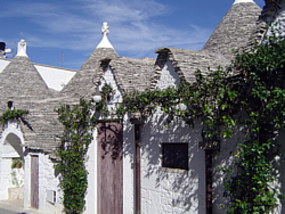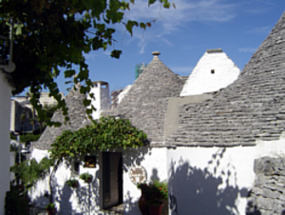Ostuni. Trulli
Ostuni
- Origins of Ostuni
- What to see in Ostuni
- Events in Ostuni
- Practicalities
- Seaside of Ostuni
- Masserie of Ostuni
- Trulli
- Museum of Ostuni
- Parks and protected areas
- Cuisine
- Images of Ostuni
- Ostuni local info
- Getting to Ostuni
Rentals
Services
- Property and land management
- Guest management
- Property restoration and reparing works
- Taxi service and taxi sharing service
- Services for disabled
Excursions
Food & Wine
Trulli houses
Trulli are traditional whitewashed buldings of Puglia with conical roofs which taper to a point or sphere called "Pinnacolo". The pinnacolo is made of hand carved stone, that may be one of many desings, chosen for symbolism.
This style of contruction is prevalent in all the surrounding countryside where the fields are separeted by dry stone walls.
How trulli are built

The cone roof is made of two layers: an inner layer of limestone boulders, capped by a keystone, and an outer one of limestone slabs ensuring that the structure is watertight. The side walls of trulli are very thick (more the 1 metre), providing a cool environment in hot weather and insulating aganist the cold in winter.
One cone of trulli and one room inside the trulli

The vast majority of trulli have one room under each conical roof: a multiroomed trullo house has many cones representing each room. So there might be a room with a small cone for the kitchen, a bigger one for the living room, a medium one for the alcove used as a bedroom. This allows for an organised and spacious home. This layout also means that you can usually tell how many rooms it has by the number of cones.
The symbols of trulli

Trulli are often adorned with a painted symbol. Their origin is unknown but they usually have a religious or astrological meaning. Symbols may include planetary signs, the malocchi (evil eye), the cross, a heart, a start, and a few others.
The origins of trulli

There are many theories about the origin of the design and the dry stone way of building the trulli. The most popular one is that due to the high taxation on property the people of Puglia created dry wall constructions so that they could be dismantled when inspectors were in the area.
The Valley of Itria
The valley of Itria is a gentle landscape covered with trulli. The plain is dominated by the hills on which are situated the cities of Locorotondo, Martina Franca, and Cisternino.
The area is rich in oak saplings, grouped into small thickets, and fruit trees and blackberry bushes crowd together between the dry stone walls dividing the fields.
The landscape of this area, one of the zones which link the Ionian to the Adriatic Sea, is a gentle one with low-lying hills stretching out against a horizon free of any higher peaks.
The wide pastures covering the hills and plain are full of large farms rearing horses and donkeys. It was here in medieval times that the armies of Venice put their animals to pasture.
How to get there: The Valley of Itria can be reached from Martina Franca, which is about 30 km from Ostuni, and Locorotondo which is about 23 km from Ostuni.
Ostuni
Ostuni
- Origins of Ostuni
- What to see in Ostuni
- Events in Ostuni
- Practicalities
- Seaside of Ostuni
- Masserie of Ostuni
- Trulli
- Museum of Ostuni
- Parks and protected areas
- Cuisine
- Images of Ostuni
- Ostuni local info
- Getting to Ostuni
Rentals
Services
- Property and land management
- Guest management
- Property restoration and reparing works
- Taxi service and taxi sharing service
- Services for disabled
Excursions
Food & Wine







